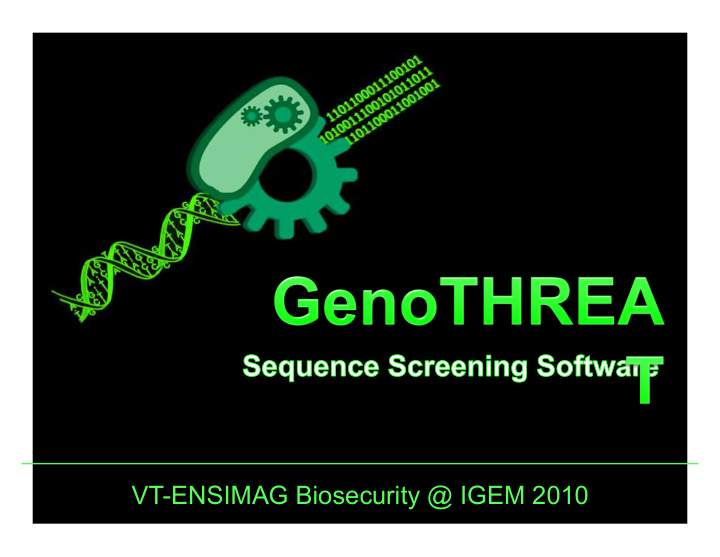



VT-ENSIMAG Biosecurity @ IGEM 2010
Road Map I – DNA Synthesis and the Industry II – GenoTHREAT Algorithm III – An Efficient Software IV – Contribution to iGEM V – Conclusions and the Road Ahead 2
How is gene synthesis evolving? Why is it important? 3
The Guardian • Ordered portion of Small Pox Sequence (2006) 4
1918 Flu Epidemic • Killed over 35,000,000 people worldwide • Reconstructed in 2005 at the CDC 5
Mycoplasma Mycoides • Synthetic genome completed in 2010 • Functional and self-replicating • Huge positive impact in the biological and medicinal field. 6
What relates the three controversial events? De novo gene synthesis What might the future hold? 7
Industry Response to Dual Use • Vague • Implementation left to Companies • Do not apply to all companies 8
U.S Government Guidance • “Screening Framework Guidance for Providers of Synthetic Double Stranded DNA” • Draft published in November 2009 • Final version published in October 2010 9
Where do we fit in? GenoTHREAT is the first implementation of the sequence screening guidance 10
Road Map I – Danger of DNA synthesis II – GenoTHREAT algorithm III – An efficient software IV – Contribution to iGEM V – Conclusion 11
GenoTHREAT algorithm 12
What should we do with subsequences? Even one Every subsequence subsequence flagged passed 13
What constitutes a dangerous sequence? Gene derived from, or encoding for, a Select Agent or Toxin 14
Is this subsequence a hit? BLAST BLAST results Score Best matches Mus musculus 100 Mus musculus Mus musculus 100 Mus musculus Danio rerio 97 Danio rerio 43 15
Is this subsequence a hit? BLAST BLAST results Score Best matches Lumpy skin disease virus 100 Lumpy skin disease virus Sheeppox virus 100 Sheeppox virus Goatpox virus 98 Dearpox virus 44 16
Is this subsequence a hit? BLAST BLAST results Score Best matches Bacillus anthracis 100 Bacillus anthracis Bacillus cereus 100 Bacillus cereus Plasmodium falciparum 63 Clostridium ljungdahlii 44 17
Road Map I – Danger of DNA Synthesis II – GenoTHREAT Algorithm III – An efficient software 1 – Database of Test Sequences 2 – Testing GenoTHREAT boundaries 3 – Time Efficiency IV – Contribution to iGEM V – Conclusions and the Road Ahead 18
Database of Test Sequences • 184 sequences manually selected straight from GenBank • Contains both dangerous and harmless sequences 19
Keyword List Content Variation Keyword list method not mentioned in guidance • Limited keyword list: uniquely composed of words in SAT List • Extensive keyword list: extension of limited keyword list containing words uniquely related to SAT. 20
Database of Test Sequences • Database of Modified sequences • Created by recombining Unmodified sequences 21
Road Map I – Danger of DNA Synthesis II – GenoTHREAT Algorithm III – An efficient software 1 – Database of Test Sequences 2 – Testing GenoTHREAT boundaries 3 – Time Efficiency IV – Contribution to iGEM V – Conclusions and the Road Ahead 22
Intervening Sequences Potential Danger: SAT sequences hidden within larger, benign sequences 300bps 200bps 300bps 300bps 250bps 300bps NSAT SAT NSAT NSAT SAT NSAT Draft Guidance sets screening limit at 200bps/66aa Conclusion: All hidden sequences were detected 23
Degenerate Sequences Potential Danger: Codon optimized nucleotide sequences Unmodified Nucleotide GATTTGGACACTCATTTCACC Amino Acid Sequence DLDTHFT Degenerate Nucleotide GATACGTCAACCTTTTAAGC 24
Degenerate Sequences • 100% of hits were correct • All due to amino acid subsequence Conclusion: Necessity of the Six Frame Translation 25
Road Map I – Danger of DNA Synthesis II – GenoTHREAT Algorithm III – An efficient software 1 – Database of Test Sequences 2 – Testing GenoTHREAT boundaries 3 – Time Efficiency IV – Contribution to iGEM V – Conclusions and the Road Ahead 26
Screening time & hardware Sequence Screening time length (bps) (min)* 2000 2 10,000 12.5 *Screening performed using business class server Conclusion: Viable at 100’s of sequences screened a day Online Desktop Business Class Server 27
Road Map I – Danger of DNA synthesis II – GenoTHREAT algorithm III – An efficient software IV – Contribution to iGEM V – Conclusions and the Road Ahead 28
The iGEM Registry Why screening the registry? Results: Initial Screen: Sequence 1 – 1724 • Real world gene order Hit Rate: 6.5% simulation • Contribution to iGEM Modified Program and Parameters Hit Rate: 2.9% Conclusion: Potentially viable in large scale applications 29
Legitimate threat identified 30
Road Map I – Danger of DNA synthesis II – GenoTHREAT algorithm III – An efficient software IV – Contribution to iGEM V – Conclusions and the Road Ahead 31
Conclusions • Screening quality dependent upon implementations • Developed test set for future research • Draft Guidance provides good framework for sequence screening software Vague on certain points Multiple possible implementation of varying quality • GenoTHREAT is a viable software: Reasonable time Accurate detection of sequences of concern Decent numbers of false positives (human review) 32
And iGEM! GenoTHREAT and the Registry: • Provide a safer working environment for students and the public • Foster development of responsible scientists 33
And iGEM! iGEM Collaboration: • Developed software to design primers USER Fusion is standard for scarless restriction Virginia United iGEM Team • Primer design is time consuming and error prone • Very useful for other teams in the future 34
The Road Ahead 35 Source: http://www.sepiamutiny.com/sepia/archives/cat_law.html
The Road Ahead NSF Award for $100,000 to continue work 36 Source: http://www.ccmr.cornell.edu/igert/
The Road Ahead GenoTHREAT Source: http://www.globalsecurity.org/wmd/intro/bio_ricin-pics.htm and http://www.bbc.co.uk/drama/smallpox2002/ and http://frameshiftcoaching.wordpress.com/2009/12/ 37
VT-ENSIMAG biosecurity Team: • Gaëlle Letort • Michael Kozar • Olivier Mirat • Arunima Srivastava • Tyler Stewart Advisors: • Dr. Jean Peccoud • Laura Adam 38
Questions?
Recommend
More recommend